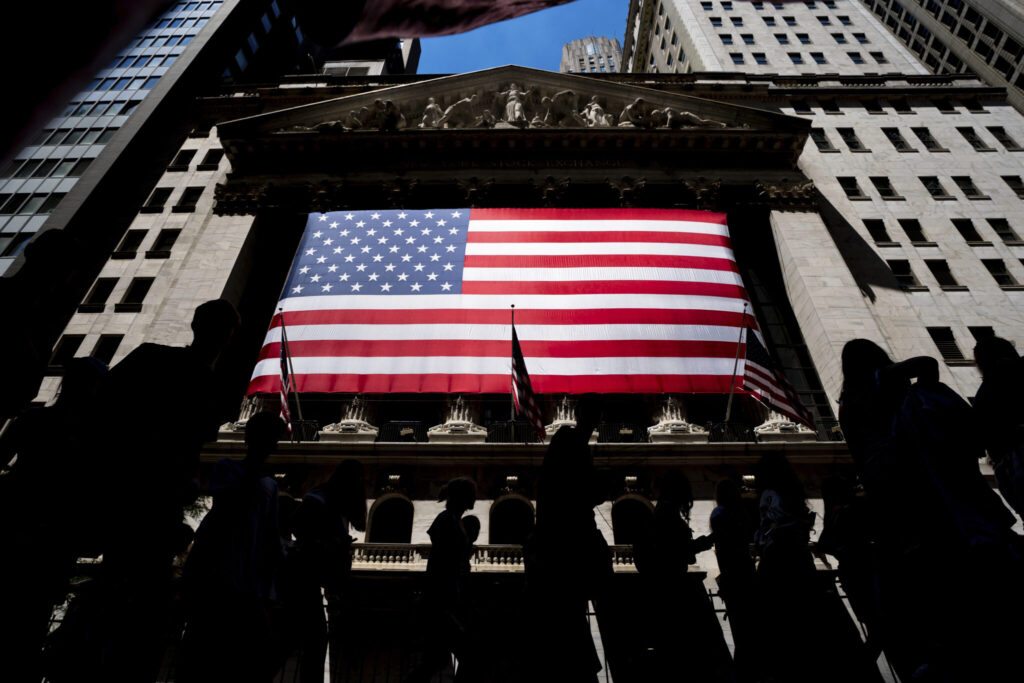Wall Street’s main indexes open lower on Tuesday after Treasury Secretary Janet Yellen said the U.S. government could run out of money within a month, while investors awaited the Federal Reserve’s policy decision. The cost of insuring against a U.S. default hit fresh highs as Yellen said the government will be unlikely to meet all payment obligations by “early June”, prompting President Joe Biden to summon four top congressional leaders to the White House next week. As well as the Federal Reserve is set to raise interest rates this week in a bid to combat high inflation. The associated Press has the story:
Stocks drop as Fed, debt limit deadline loom
Newslooks- NEW YORK (AP)
Stocks are falling Tuesday as Wall Street waits for the Federal Reserve’s latest move on interest rates and watches Washington edge closer to what would be a catastrophic default on U.S. government debt.
The S&P 500 was 1.1% lower in early trading. The Dow Jones Industrial Average was down 379 points, or 1.1%, at 33,672, as of 10:22 a.m. Eastern time, while the Nasdaq composite was 0.9% lower.
Some of the sharpest action was among companies that reported results for the first three months of the year, as earnings season stays in high gear.
Arista Networks fell 12.1% despite reporting better profit and revenue than expected. Analysts said investors may have been disappointed it didn’t raise its forecast for upcoming results even more than it did.
DuPont dropped 8.9% after also turning in stronger profit and revenue than forecast. It lowered the top end of its forecast for revenue this year, saying it expects improvements in the electronics markets to come later than earlier thought.
On the winning side was Molson Coors Beverage, which reported adjusted earnings that more than doubled analysts’ expectations. It jumped 8.7%.
But the biggest question on Wall Street remains what the Fed will do as it begins a two-day meeting on interest rates. The widespread assumption is that it will raise rates on Wednesday by another quarter of a percentage point. The widespread hope is that it will be the last increase for a long time.
The Fed has jacked up rates at a furious pace from early last year, up to a range of 4.75% to 5% from virtually zero. It’s trying to beat down high inflation, but high rates do that by taking a blunt hammer to the economy. It raises the risk of a recession and hurts investment prices along the way.
High rates have already hit the housing market sharply, while causing cracks in the banking system that have resulted in three of the four largest U.S. bank failures in history since March. Many investors are preparing for a recession to hit later this year.
That has many traders betting on the Fed halting its rate hikes and perhaps even cutting them later this year. That would offer the market more breathing room, and stocks have historically done well in the months immediately following the last rate hike.
Still, some investors are anticipating the Fed on Wednesday may not give any encouraging signals that rate hikes are definitely over, let alone open the door to rate cuts.
“Admittedly this is a 20:20 hindsight view and the Fed’s job is as tough as it has ever been, but while it would be nice to be finished with the Fed hiking cycle, too much caution in the past, among other factors, caused the current inflation overshoot and there remains a distinct possibility that it could accelerate again, especially given all the uncertain factors in the world today,” said John Vail, chief global strategist at Nikko Asset Management.
Australia’s central bank earlier Tuesday surprised markets by raising interest rates by a quarter of a percentage point and saying “some further tightening” may be needed to get inflation fully under control. It pointed to prices rising still too quickly for services, an area that the Fed has also been focused on.
Adding worries on top of that is the latest political spat over the nation’s debt limit. Treasury Secretary Janet Yellen said late Monday that the U.S. government could default on its debt as early as June 1 unless Washington allows it to borrow more. That’s an earlier “X-date” than previously thought.
A default could be disastrous because much of the financial system is built on the assumption that U.S. government debt is the safest investment available. Most of Wall Street believes Congress will come to a deal before the deadline, as it has many times before, because the alternative would be so dire.
While Yellen made the June 1 deadline sound like a flexible one, Wall Street will likely be treating it with more definitiveness. Any portfolio manager investing clients’ money with instructions to avoid anything at risk of getting payments delayed will be steering clear of June 1 bills, according to strategists at UBS.
With only weeks to go before June 1, Congress could be forced to kick the can down the road and agree to an extension of a few months, rather than a long-term deal.
“There could be a few debt ceiling deadlines prior to the 2024 elections,” the UBS strategists led by Michael Cloherty wrote in a report.
In the bond market, the yield on the 10-year Treasury fell to 3.46% from 3.57% late Monday.







